Search Engine Optimization (SEO) Trends in 2021

Author : Arul Selvan 3rd Feb 2021
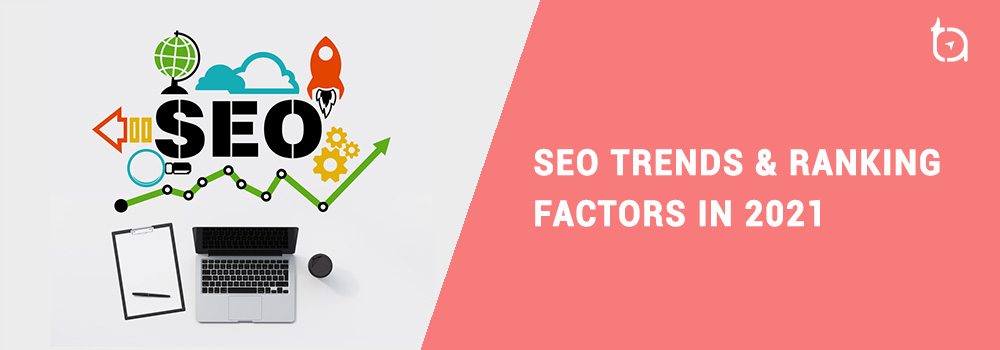
Search Engine Optimization (SEO) is the process of optimizing the website to rank higher on the search engine results pages (SERPs). SEO is vital for any online business because it helps in gaining quality traffic, building brand awareness, staying ahead of your competitors, improving sales conversion, and cost-effective results. The below image clearly shows that 76% of the traffic is via Search across the industries and emphasizing the importance of SEO in 2021.
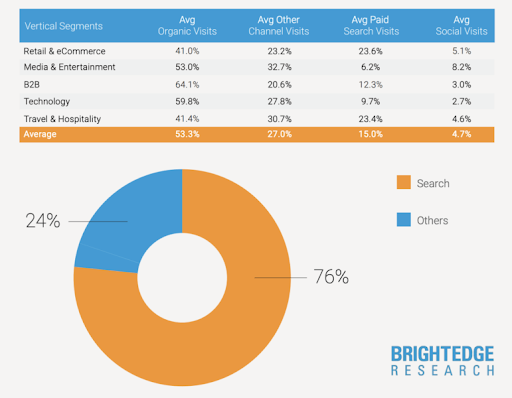
As long as you embrace modern SEO best practices then the improvement of rankings on search engines will become a lot easier and those factors are listed below
- Passage Indexing
- Schema Implementation
- Voice Search
- Video Marketing
- Core Web Vitals
Passage Indexing:
Google introduces Passage indexing as a ranking factor in its latest algorithm and it means Google will show the most relevant passages in the results based on the query of the user. The way Google indexes the pages is not going to be changed but while crawling those pages Google will try to figure out each content of the passage.
How does Passage Indexing work?
For example, if you search like “ how can I determine if my house windows are UV glass?” the passage which is more relevant to the query will appear in the results as shown in the image below
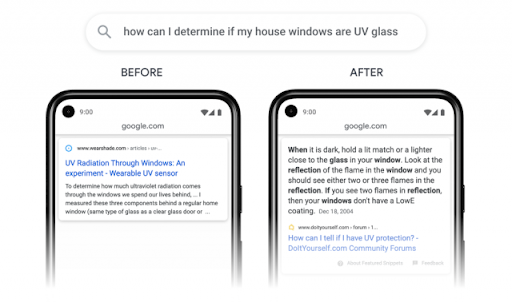
Is Featured Snippet and Passage Indexing the Same?
No, they are not the same. The featured snippet results look for the page’s topic relevance whereas the passage indexing doesn’t consider the page relevance but the relevance of passages for the keyword user typed in the search engine.
Using subheadings, answering the user’s questions in your blog post content will play a huge role in the organic rankings once passage indexing is rolled out.
Schema:
The importance of schema in SEO is unnegotiable as it enhances the search results of the website once it is added to the web pages. The results are displayed in the form of a rich snippet.
Schema is a set of code that is added to the webpages of your website to improve the way it is displayed in the search results. There are different types of the schema as follows

Will Structure data affect the rankings of the website?
There is no enough evidence to determine that implementing a schema will affect the rankings of the website, but it will improve the search engine results click-through rate (CTR) of the website.
Tools like TechnicalSEO will help to generate the schema if you are not a coding expert. Therefore, implement schema to your website and measure its results to see the effectiveness of it in search engines.
Voice Search:
Voice search is revolutionizing search engine optimization since its inception and voice technology has evolved over the years, so users can give commands like humans. According to Google, 52% of people have voice-activated speakers in their living room.
How to Optimize for Voice Search?
The way humans speak is not the same as the way they write. Hence, it is essential to optimize the content for the long-tail keywords. Backlinko says the average words in length for voice search is 29. Optimizing for the long tail keyword increases the probability of conversion as shown in the image
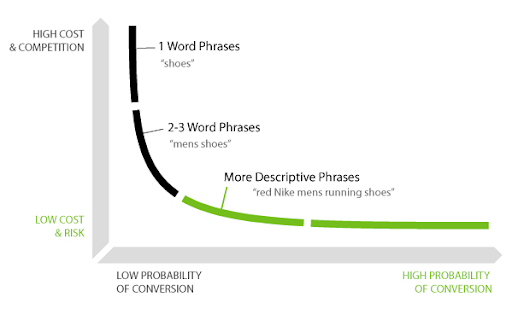
Google’s Rankbrain and Hummingbird algorithms are designed to recognize the words and to handle them efficiently. WH questions like “Who”, “What, “Why”, “When”, “How” are the words repeatedly used by the voice search users. Tools like answerthepublic and questionhub will help you to find the question types keywords. Using the FAQ schema may benefit the websites for optimizing these types of voice search questions. It is crucial for SEO’s to optimize for the voice search as its usage is on the stellar rise.
Video Marketing:
Ever since Google acquired Youtube it made an incredible effort to better it and now it is the second most popular search engine in the world after Google. According to Youtube, more than 1 billion hours of videos are watched by users every day.
How to do Video SEO?
Video marketing doesn’t help your business (or) organization on youtube alone but also helps on Google as it is displaying the youtube videos in its SERP’s for some queries of the users as shown below
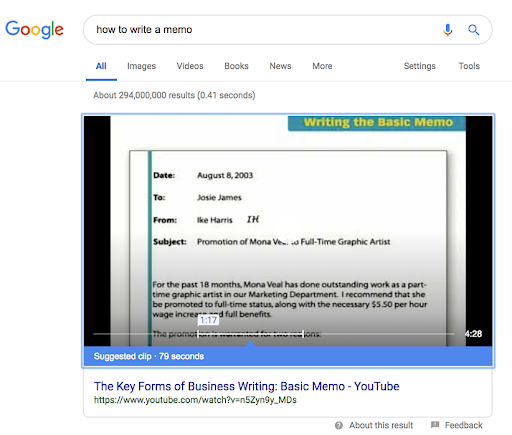
Creating a video is never enough because if it doesn’t get the views and your brand will not get the exposure it wanted. Hence, Youtube SEO is vital to achieving your goal in video marketing. The things to be optimized for the Video SEO are as follows:
Metadata Optimization:
Video Title:
The video title optimized with the keywords is more vital for the Youtube Rankings. Hubspot states that 80% of the featured snippets in Google contain keywords in the title.
Video Description:
The meta description of the video should also be optimized for keywords and insert your core keywords within the first 157 characters because youtube truncates the words after it from the users. The maximum word length for the youtube description is 5000 words and try to use it as effectively you can.
Video Tags:
The tags for the video helps the search engines to understand the video easily. Taggenerator and Rapidtags will help you in generating the tags for your videos. According to Brigssgy, 31 – 40 tags are the ideal number of tags, and adding more than that reduces the efficiency of the tags.
Tools like Videoiq and tubebuddy will help in efficiently optimizing your videos.
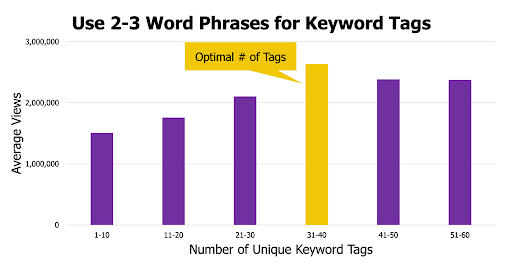
Core Web Vitals:
In addition to existing search signals like mobile-friendliness, safe-browsing, HTTPS-security, and intrusive interstitial guidelines, Google is adding this core web vital as another Signal. Tools like PageSpeedInsights and GTMetrix will help in optimizing the Core Web Vitals.
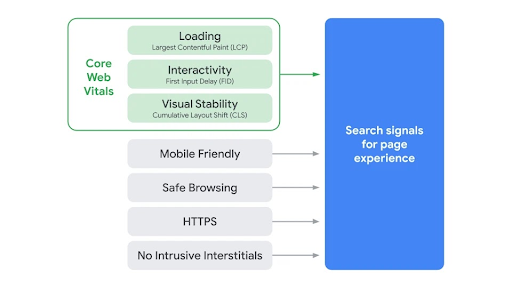
What are Core Web Vitals?
Largest Contentful Paint (LCP), First Input Delay (FID), Cumulative Layout shift (CLS) are combinedly known as the Core web vitals.
Largest Contentful Paint (LCP):
The average time which the webpage takes to load from the point of the actual user. If the webpage takes 2 seconds means then it is “Good”, whereas if it loads in 4 seconds means then it is considered as “Improvement Needed”, and anything above that is considered poor. To improve the score of LCP do the following:
- Remove the unnecessary external scripts
- Try to upgrade your web hosting service
- Use Lazy Loading
- Delete (or) replace the large page elements
First Input Delay (FID):
The time it takes for the user to interact with your webpage is known as the First Input Delay. The interactions can be anything like
- Clicking the button
- Using the navigation menu option
- Signing up a form
The time duration 100ms is considered as good, anything above 100ms to 300ms needs improvement and above 300ms is bad.
Minimizing the Js, Using the browser cache helps in reducing the page elements to load and enhances the interaction time.
Cumulative Layout shift (CLS):
The stability of the page is measured in Cumulative Layout shift i.e. if the elements of the page move during the page load then the CLS is high which is terrible. To prevent the instability of the page always do the following
- Always mention dimensions for any media uploaded to the website
- Make sure the web page is loaded and working correctly in both the Production and Development environment
- Ensure the reserved space for ads on your website, because it can appear anywhere on the page suddenly which causes the instability to page by pushing up (or) down the content as shown in the image below
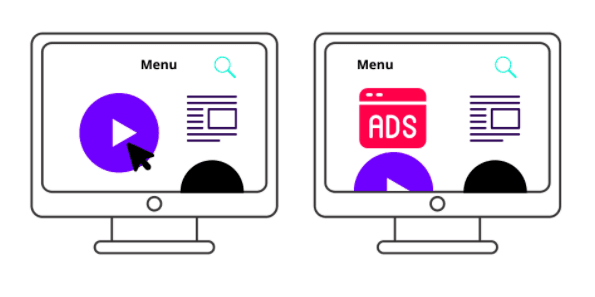
Conclusion:
Search Engine Optimization(SEO) has evolved over the years and still, it is one of the important factors for the success of your online Branding and sales. If you need any assistance in improving your SEO for 2021 and beyond, you can reach out to us at media@techaffinity.com or contact our experts
